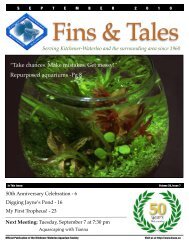A P R I L 2 0 1 0next to the Great Wall of Foam in the tank. Yes, as it turns out,foam pre-filters have feelings too! I did, however, keep theplastic pump inlet guards in place, just in case some unluckyfish manages to jump the foam sheet and get to this side of thetank.My geeky math skills tell me that these pumps should turn overthe tank's 125 gallon water volume roughly 10 times per hour.Taking the tank cross-sectional area into account, if the flowmoves evenly through the foam filter sheet, it would travelthrough it at just under 1/4” per second. It's amusing to thinkabout how much more water movement is in this tankcompared to most other freshwater tanks, but at the same timehow it's one or two orders of magnitude less than a river or ashallow, fast-moving stream-bed. Nature may often beimitated, but it is never really duplicated.For the final assembly steps, I cemented the base PVC manifoldpieces together after the dry fit. Thank goodness it still fit intothe tank after this step! Then I added the riser pieces for thespray bars and pump inlets at either end. After playing arounda bit, I finalized the pump layout to minimize space behind thesponge but also keep the pump intakes as low as possible. Thepump housings were placed down onto spare pieces of foam inan attempt to limit vibration coupling and noise. As a sidebenefitto this, I now have room to press down on the pumpbody to separate the pump from its manifold at the short, noncemented1/2” PVC joining piece. This would be useful forpump servicing or replacement if needed.to be shorter than the other, the bottom spray bar leans in a bitto pass in front of the riser for the upper bar.Now let's make one thing clear―I can play around with sometank filtration stuff, but when it comes to the inhabitants andoverall tank style, my wife still dictated the terms. Yes, dear, itwill still be a planted tank! We reused our old CO2-injectionequipment, which consisted of a small CO2 tank, Milwaukeeregulator, and pH monitoring system with cutoff solenoidvalve. Previously, the intake to our Magnum 350 canister filtermade for a convenient CO2 reactor to dissolve and disperse theCO2 into the tank water. For this new setup, I fed the CO2 intoone of the pump intakes. The pump's impeller and the 6 feet ofPVC manifold pipe make for a good reactor as well. Once air ispurged from the system, only occasional tiny bubbles are visiblecoming out of the spray bars. I also fed the CO2 into the pumpaligned with the lower spray bar, so the majority of the CO2 isinjected into the base of the tank and not close to the surface.To finish off the remaining tank “hardware”, I filled the gapsbetween the PVC manifold tubes with Eco-Complete substrateand then placed a few mounted driftwood pieces on top. Afterthese slate pieces were covered with a final layer of substrate, itssurface ended up about 3” above the tank base. Tank lightingcomes from two 36” dual-96-watt power-compact fixtures fromthe States.For the outlet spray bars, I placed end-caps on two 3/4” PVCpipe sections and then drilled twelve ¼” holes along the lengthof each. The two spray bar risers are at different heights, so onespray bar end up being 6” from the gravel and the other isabout 6” from the top of the tank. The spray bars themselvesaren't cemented in place, so they can be twisted around, orremoved to be cleaned or replaced if needed. Since the risersaren't at the very corners of the tank and I didn't want one barOnce the tank was filled up, we started filling the tank in withsome plants from Big Al's as well as a nice plant kit from Ed“sucker4plecos” Koerner. After a few weeks of cycling, someBristlenose plecos moved in, and then a colony of 50 cardinaltetra took up residence a couple of weeks later.As far as initial impressions go, the first thing that strikes me isthat those Mag-Drive units are loud! They are mainly designedfor ponds, and while they aren't overly loud by themselves, itreally doesn't help that they are coupled via rigid PVC pipe tothe manifold and then the bottom glass of the tank. They arealso somewhat inefficient, consuming about 70 watts each 2418
A P R I L 2 0 1 0hours per day. Once I fitted some Coroplast lids to the tank top,the tank temperature started rising fast! I now have to keep onelid propped up to allow for airflow and evaporation, whichcools the tank back down to about 78 degrees in winter and 81degrees in summer without any additional heating. Because ofthe higher water temperature, the tank isn't perfectly suited tospecies from cool-water mountain streams after all.In terms of plants, we have found that the tank space near thespray bars is well-suited to shorter plants like smallerCryptocoryne species and Anubias plants. The long, flowingValisneria work well along the tank's back wall, where there isactually some counter-flow back towards the spray bars. I thinkthis is because of the lower spray bar leaning out towards thefront glass a bit. We also found quickly that the glass andplumbing behind the big sponge quickly grew over with algae.Floating plants are now used on that side of the tank to reducethe light penetrating into the water and keep the algae levelsdown. I just scoop out some excess floaters any time that I do awater change on the tank.Speaking of water changes, they have become dirt-simple withthe vertical riser and garden-hose adapter. I turn a couple ofvalves, unplug one of the pumps (to prevent a waterfall effectinside the tank when the level drops), and it only takes 10minutes or so to drop the tank volume by half. I do these 50%water changes every 3 to 4 weeks now, which is much betterthan when we were in Indianapolis and it took siphons to drainthe tank. Some mulm and detritus collects on and around thepumps in the area behind the sponge, so I use a spare PVC tubeto stir it up while the tank is being pumped out. This is reallythe only mechanical filtration or “filter cleaning” that I haveever done on the tank.So how has the Great Wall of Foam fared? The sponge became'dirty' pretty quickly after the plants and fish took up residence,but after over a year, it has not yet collected enough crud toimpede water flow. There might be a 1-millimeter difference inwater level between the two sides of the tank now. Ammoniaand nitrite levels in the tank remain undetectable even afterchanges in the fish load.There is one down-side to the current setup. The large porosityof the 4” Poret foam that I chose combined with the fairly fastwater flow means that fine particulate filtration isn’t the best.A couple of weeks after a water change, small particles arevisible suspended in the moving tank water. The issue is moreevident after a water change, where the water itself looksnoticeably clearer. I'm sure that slowing the tank flow wouldhelp with this, as would using a finer porosity sponge or someadditional mechanical filtration of some sort. But for now Ican't be bothered to change anything.Now that I've finished this project and lived with it for over ayear, if I were to repeat it there are a few things that I would dodifferently:• Use plastic or rubber tubing to couple the pumps to the PVCmanifold. I think this would go a long way to reducing noiseby preventing pump vibrations from coupling to the tank.• Move the CO2 inlet past the pump impeller to reduce bubblenoise. A piece of rigid air tubing could be placed into themanifold after the pump output and directed with the waterflow so that it creates a venturi effect and sucks CO2 into themanifold. I think the water movement in the manifold itselfwould do a great job of dissolving CO2 into water beforebeing sprayed out into tank.• Find more efficient pumps, so that heat isn't as much of anissue. A newer stream tank design found online uses a largerecirculating channel at the back of the tank, fed by anefficient propellor-based powerhead designed for movingwater around in marine tanks.• To really cater to species native to mountain streams such asthose in the Hillstream Loach family, reduce the plant loadand lighting and substitute the CO2 injection system with anair pump to increase dissolved oxygen content in the water.Overall, I have greatly enjoyed designing, building, andviewing the results of my DIY river tank system. It was a funlearning experience, and I hope that others might take away afew DIY ideas to roll into projects of their own. - RyanSpeaking of fish load, the tank's current occupants now includea colony of 9 clown loaches, a couple of angelfish, Cardinal andother tetra species, one large common pleco, several bristlenoseplecos, and various Corydoras. Frankly, I'm surprised at howmuch time the angelfish will spend close to the spray baroutlets―I was worried that they wouldn't care for the fastmovingwater, but quite frankly they don't seem to mind at all.Other plants that we have kept in the tank include Limnophilasessilflora, Sagitaria and Ludwigia species, sunset Hygro, Bacopamonnieri, a dwarf water lily, and lots of Java ferns. While somestring algae may appear on the stem plants occasionally, theonly other algae with significant presence would be the blackbeardstuff―it loves the spray bar outlet holes and the Anubiasleaves and roots near the high water flow. 19














